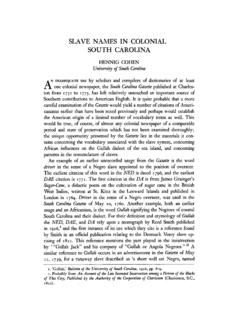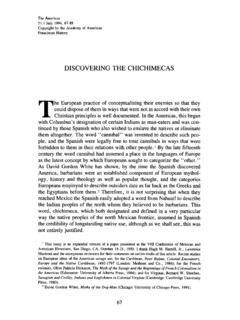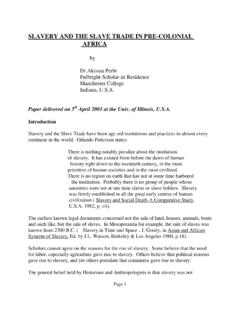Transcription of Free Negro Owners of Slaves in the United States in 1830
1 DOCUMENTS 41 free Negro Owners OF Slaves IN THE United States IN 1830 Taking up the study of the free Negro in the United States , the Research Department of the Association for the Study of Negro Life and History decided to make this statistical report as to the heads of families, their ownership of Slaves and social relations with the whites. The aim was to facilitate the further study of this neglected group. Most of these people have been forgotten, for persons supposedly well informed in history are surprised to learn today that about a half million, almost one-seventh of the Negroes of this country, were free prior to the emancipation in 1865.
2 These names will, therefore, serve as a link between the past and present and will thereby lessen the labor of research in this field. There were several reasons for selecting the census records of 1830. In the first place, the earlier reports do not give as much information as the census of 1830. At that time, moreover, the free Negroes had about reached their highest mark as a distinct class. The reaction which set in earlier in the century restricted their freedom and in many cases expelled them from the South. This census, then, evidently reports the names of a larger number of rep- resentative free Negroes than any other census prior to their debase- ment to a lower status or their migration from the South.
3 This trek reached its highest point between 1830 and 1835. Most of the free Negroes in the North in 1830, had been there for some years. The census records show that the majority of the Negro Owners of Slaves were such from the point of view of philanthropy. In many instances the husband purchased the wife or vice versa. The Slaves belonging to such families were few compared with the large numbers found among the whites on the well developed plantations. Slaves of Negroes were in some cases the children of a free father who had purchased his wife. If he did not thereafter emancipate the mother, as so many such husbands failed to do, his own children were born his Slaves and were thus reported by the enumerators.
4 Some of these husbands were not anxious to liberate their wives immediately. They considered it advisable to put them on proba- tion for a few years, and if they did not find them satisfactory they would sell their wives as other slave holders disposed of Negroes. For example, a Negro shoemaker in Charleston, South Carolina, 42 JOURNAL OF Negro HISTORY purchased his wife for $700; but, on finding her hard to please, he sold her a few months thereafter for $750, gaining $50 by the transaction. The writer personally knew a man in Cumberland County, Virginia, whose mother was purchased by his father who had first bought himself.
5 Becoming enamored of a man slave , she gave him her husband's manumission papers that they might escape together to free soil. Upon detecting this plot, the officers of the law got the impression that her husband had turned over the papers to the slave and arrested the freedman for the supposed offense. He had such difficulty in extricating himself from this complication that his attorney's fees amounted to $500. To pay them he dis- posed of his faithless wife for that amount. Benevolent Negroes often purchased Slaves to make their lot easier by granting them their freedom for a nominal sum, or by permitting them to work it out on liberal terms.
6 John Barry Meachum, a Negro Baptist minister in St. Louis, thus came into possession of as many as 20 Slaves by 1836. The exploitation type of Negro slaveholder, moreover, sometimes feeling the sting of con- science, liberated his Slaves . Thus did Samuel Gibson, a Negro of Mississippi, in 1844, when he brought his six Slaves to Cincinnati, Ohio, and settled them on free territory. Practically all of these Negro slaveholders were in the South., 1 These facts were extracted from the manuscript returns of those who took the census of the United States in 1830. After C. G. Woodson, the editor, had first copied the records of one state to acquaint himself in detail with the information given in these census reports, the statistics were then copied under his direction by three persons.
7 One of them has had the advantage of two years' niormal training, after finishing high School and two of whom have finished college courses at Howard University and at the University of Michigan. The matter thus collected was then verified by Mr. Alrutheus A. Taylor, an alumnus of Michigan and a Harvard Master of Arts in History and Economics, now employed as Associate Investigator of the Association for the Study of Negro Life and History. Further verification was made by C. G. Woodson. These records were copied just as those who took the census returned their findings. The only change made in the case of Negro Owners of Slaves was to write the family name first, a rule which these enumerators did not all follow.
8 Some enumerators made no distinction as to race in recording the names, but merely indicated the status of the head of the family under free persons of color. Other enumerators wrote Negro or Colored or used F. of C. for free person of color, F. M. C. for free man of color, or F. W. C. for free woman of color, directly after the name. The question mark after a name or a figure or in a column indicates that the record is such that the fact could not be accurately determined. DOCUMENTS 43 Slavery, however, at that time had not been exterminated altogether in the North, and even there the Negro was following in the foot- steps of the white man, as this report will show.
9 In the South where almost all of the Negro slaveholders were found, moreover, we find some of them competing with the large planters in the number of Slaves they owned. Most of such Negro proprietors lived in Louisiana, South Carolina, Maryland and Virginia, as did the majority of all such slave Owners . There are, moreover, a few instances of confusing absentee ownership with Negro ownership. Sometimes a free Negro had charge of a plan- tation, but did not own the Slaves himself, and the enumerator re- turned him as the owner of the Slaves . Excepting those of Louisiana, one may say that most of the Negro Owners of Slaves lived in urban communities.
10 In those parts of the South where the influence of the kind planter near the coast was not felt the Negro owner of Slaves did not frequently appear. The free Negroes themselves, moreover, encountered such difficul- ties in the lower South and Southwest that they had to seek more hospitable communities in free States . By 1840 the trend toward degrading the free Negro to a lower status had become evident even in the apparently benevolent slave - holding States . Just before the outbreak of the Civil War the free Negro was receiving practically no consideration in the South and very little in the North. History here repeats itself, then, in show- ing the varying attitude of the whites toward the blacks in the cycles of national development.




